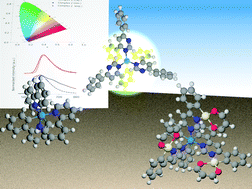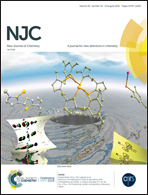Accurate computations to simulate the phosphorescence spectra of large transition complexes: simulated colors match experiment†
Abstract
Herein, an ab initio investigation on the luminescence properties of three iridium(III) complexes is reported. The first two complexes solely possess one metal atom whereas the third complex includes one iridium(III) and three platinum(II) centers. First, the simulated geometric parameters and electronic absorptions are discussed and compared with the available experimental data. On these grounds, the triplet excited state of each compound obtained via an unrestricted computation has been investigated. Simulations of the phosphorescence spectra have been performed using the so-called adiabatic Hessian approximation, which takes into account mode-mixing (Duschinsky), and the solvent effects have also been included in our simulations. Our simulated spectra are also compared with the experimental ones already reported in the literature and are found to be in great agreement, especially when the temperature effects are included. Finally, an analysis of the normal modes responsible for the vibronic signatures has been performed. The method discussed herein is cost-effective and may be used on a large set of structures.



 Please wait while we load your content...
Please wait while we load your content...